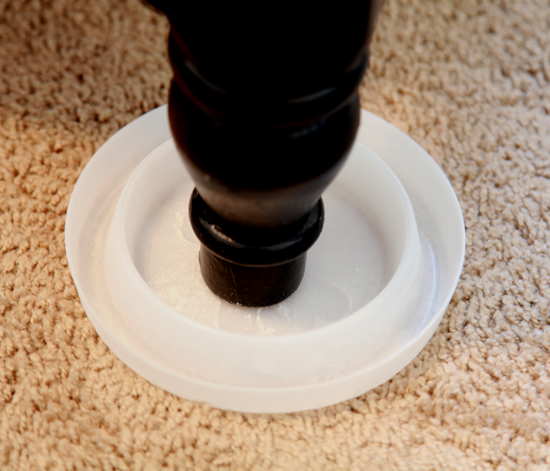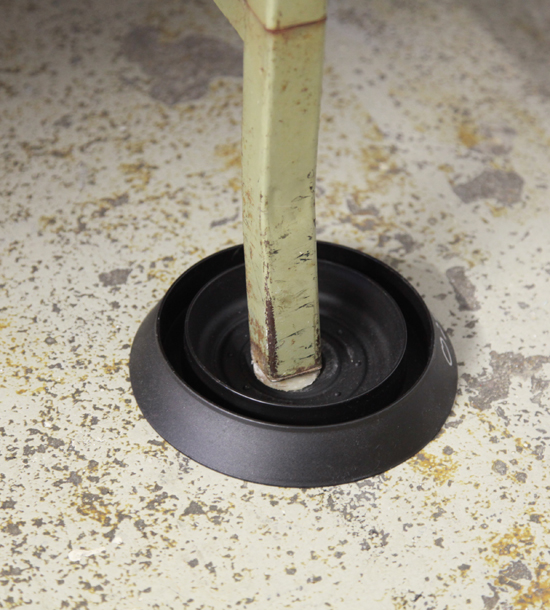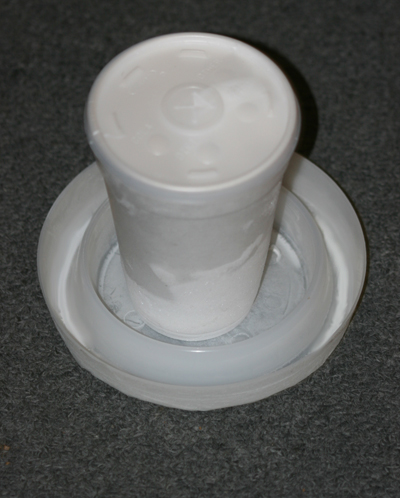
The ClimbUp® interceptor includes a light dusting of talc that must be replenished every time the trap is cleaned. The outside of the the cup is covered with fabric tape to help bed bugs climb to enter the trap.
One of the most useful devices that has been invented for bed bug monitoring and management is the bed bug interceptor. These are simple devices based on the principle that bed bugs are not very good at climbing slippery, vertical surfaces. Interceptor cups usually consist of a plastic dish large enough to contain a bed post, with an outer “moat” designed to catch and retain bed bugs. Sometimes these traps are referred to as pitfall traps for bed bugs.
The moat on an interceptor cup will have vertical, or near vertical, sides. Sometimes a light coating of talcum powder is added to the inside of the cup to make it more difficult for the bed bug to escape the moat (Note that talc itself is not toxic for bed bugs, and only a very fine film is needed–too much will make it difficult to see bed bugs in the trap).
Uses for interceptor cups include:
- Protecting bed occupants from bed bugs not already on the bed.
- To see whether bed bugs are present, and in what numbers.
- To assess the effectiveness of bed bug treatments.
- As an early detection system for bed bugs in hotels, apartments, homes.
- As part of a do-it-yourself bed bug management effort.
How to Use

The Blackout™ Bed Bug Detector does not require talc. Roughened plastic on the outside facilitates bed bug entry.
Interceptor cups should be placed under the posts of beds needing protection from bed bugs. To maximize protection it is important that beds not touch walls or any nearby furniture. Dust ruffles or any bedding that touches the floor will also keep the interceptors from serving as protection from bed bugs. For monitoring purposes, interceptors can be placed under bed posts, or anywhere under the bed. Interceptor cups will be most effective when used on bed where someone is sleeping, with the person serving as an attraction for the bugs. Interceptors can also be placed under sofas or upholstered or wicker furniture where bed bugs may hide. Recent research shows that bed bugs are highly mobile and may be found throughout homes, even in areas where you might not expect to find them. Interceptors may be placed in bathrooms, kitchens, hallways, or anywhere desired.
To fully monitor a typical two bedroom apartment, a minimum of 12 interceptors is best (assuming four cups per bed, and two cups per sofa and recliner chair). If protection of the beds is less important than early detection or monitoring, two cups per bed is OK. Dust and debris will accumulate in traps and must be cleaned periodically, usually at least once a month. When checking interceptor cups, it may be easiest to dump them in a smooth-sided plastic tub to help you inspect the contents of the trap. By using a tub with vertical sides, you can minimize the chance of bed bugs escaping before they can be dispensed with. Dump live bugs into soapy water or place in a plastic bag and dispose in an outdoor trash receptacle.

A thermos or even styrofoam cup filled with dry ice and placed in the center of an interceptor can enhance the effectiveness of the trap for detecting bed bugs.
The effectiveness of an interceptor trap for bed bugs can be enhanced if coupled with a carbon dioxide source or pheromone attractant. This can be especially useful for pest management companies or building managers who wish to determine whether bed bugs might be present in empty apartments, empty school classrooms, work places or other locations where bed bugs may be difficult to detect. It is best to use CO2 traps over weekends or holidays in school or work sites. Take caution when using dry ice in areas where children might be present. In small rooms, CO2 can be toxic; and dry ice may cause burns if handled without gloves. In occupied rooms, or locations children might encounter the traps with dry ice, traps should be used with lure only, or without additional attractant. Traps without a lure can still serve as effective bed bug detectors.
Where to Purchase Interceptors
Bed bug interceptors or monitors are not generally available in stores, but can be purchased online. Two popular manufacturers include ClimbUp® and Blackout™ bed bug interceptors. You may also want to search online for terms “bed bug monitors” or “bed bug interceptors”. There is also now a newer trap design that is smaller and designed to place in discreet locations around the home. Called the Volcano™ bed bug detector, it is designed to hold a lure to enhance trap effectiveness. Because of its small size, the Volcano™ will not provide bed protection, but is designed purely as a monitor. All of these traps can be found online via a search engine.
If you can’t afford commercial traps or need to get interceptors installed immediately, you can also make your own bed bug interceptor traps with a few simple household items. For a video on how to do this from the University of Florida, please click here.
